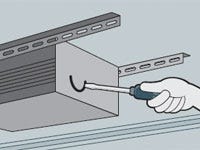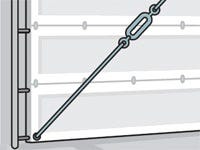How To Fix A Sagging Garage Door Panel

Michelle Pedone/Getty Images
Your garage is supposed to prevent trouble by keeping your car safe from the elements (and from thieves), but sometimes garages have problems of their own. Garage doors won't open, refuse to lock or age and warp. Garage door repair is can be costly, but these basic tips will keep your garage door running smoothly all year long.
The Power Goes Out

The power to your garage is out with the door shut, and you need to get your car out or you'll have to take a bus. You'll notice a cord—usually with a red handle—dangling down from the guide track that the opener uses to open and close the door. This is the manual override. Once pulled, it allows you to open and close the door with your own power in the form a little elbow grease.
Frozen Garage Door

Cold weather has stiffened the mechanism of your garage door opener and caused it to lose power. Most garage door openers made in the past 15 years have pressure adjustments for both raising and lowering. Check and adjust these settings seasonally to keep things running smoothly.
Sagging Garage Door

That sagging garage door is getting harder and harder to open. Garage doors, especially older, wooden models, are as susceptible to the ravages of time and gravity as the rest of us. If your aging doors are a little saggy, square them up with the tension rods positioned on the back of the door. The rods are placed diagonally from top to bottom corners and can be tightened at a turnbuckle to straighten out the door--do a little at time to allow the door to adjust to the change. If your door isn't already equipped with tension rods, you can buy them at home centers.
Lock Your Garage Door

Your dream car is parked in out of the elements, but it's not secure because the garage door won't lock. Most garage doors have two horizontal bars that move out from the center of the door into slots along the side of the door in the door track, effectively locking the door in place. Over time, these bars can shift slightly out of position so that they are no longer correctly aligned with the locking slots. To realign the bars, unscrew the guide brackets on the edges of the door so that they are loose enough to move, and then reposition them so that they smoothly guide the locking bars into the locking slots. Lubricate the lock mechanism with machine oil and you're done.
Soak Up Oil Stains

After working on the car, you find a big oil stain on the driveway. Pulverize a scrap piece of drywall with a hammer (any new home construction site will have dumpsters full of waste pieces of drywall). Crumble the pulverized drywall with your hands and sprinkle on the stain. Leave it overnight, and rinse off in the morning. Reapply and brush in with a bristle broom in cases of stubborn stains.
When to Call the Pros
Although small stains and cracks can usually be fixed with store-bought products and a little elbow grease, bigger troubles in your home's masonry walls call for more expertise. Bring in a mason or structural professional when:
+ A crack in a masonry wall is large and growing rapidly.
+ A foundation wall appears to have shifted.
+ You find large patches of black mold on the wall.
+ The wall is actually buckling.
+ Bricks, mortar, or stucco simply crumble away to dust at your touch.
This content is created and maintained by a third party, and imported onto this page to help users provide their email addresses. You may be able to find more information about this and similar content at piano.io
How To Fix A Sagging Garage Door Panel
Source: https://www.popularmechanics.com/home/outdoor-projects/how-to/a3403/garage-door-repair-tips/
Posted by: campbellhavot1998.blogspot.com

0 Response to "How To Fix A Sagging Garage Door Panel"
Post a Comment